Spatiotemporal Analysis of Precipitation in the Sparsely Gauged Zambezi River Basin Using Remote Sensing and Google Earth Engine
Abstract
1. Introduction
2. Materials and Methods
2.1. Study Site
2.2. Data
2.3. Methods
2.3.1. Construction of Time-Series Precipitation
2.3.2. The kendallsCorrelation Reducer
2.3.3. The sensSlop Reducer
3. Results
3.1. Annual Trend of Precipitation
3.2. Seasonal and Monthly Trend of Precipitation
4. Discussion
4.1. Results Comparison and Analysis
4.2. The Drivers of Precipitation Variability
4.3. Suggestions on Agriculture Management
5. Conclusions
Author Contributions
Funding
Acknowledgments
Conflicts of Interest
Appendix A
| Year | CUA | LUN | LUA | UZI | KAB | BAR | KAF | LUA | MUP | NIA | KAR | TET | ZDA | Max Sub-Basin | Min Sub-Basin |
|---|---|---|---|---|---|---|---|---|---|---|---|---|---|---|---|
| 1998 | 708 | 1237 | 1051 | 1332 | 1275 | 838 | 1115 | 1024 | 962 | 1265 | 797 | 1099 | 1369 | ZDA | CUA |
| 1999 | 824 | 1197 | 1030 | 1218 | 1097 | 896 | 989 | 924 | 795 | 998 | 947 | 929 | 984 | UZI | MUP |
| 2000 | 776 | 1255 | 1152 | 1302 | 1308 | 910 | 1284 | 1264 | 964 | 1372 | 958 | 1210 | 1628 | ZDA | CUA |
| 2001 | 675 | 1109 | 962 | 1131 | 1063 | 723 | 857 | 868 | 633 | 1220 | 576 | 741 | 784 | NIA | KAR |
| 2002 | 603 | 1174 | 1028 | 1301 | 1207 | 738 | 985 | 1074 | 810 | 1214 | 595 | 835 | 971 | UZI | KAR |
| 2003 | 979 | 1175 | 1285 | 1214 | 1122 | 1064 | 935 | 998 | 846 | 1033 | 801 | 809 | 875 | LUA | KAR |
| 2004 | 608 | 1110 | 840 | 1176 | 1095 | 632 | 786 | 973 | 676 | 1078 | 567 | 783 | 806 | UZI | KAR |
| 2005 | 952 | 1235 | 1051 | 1355 | 1237 | 1013 | 1090 | 1091 | 921 | 1171 | 891 | 895 | 989 | UZI | KAR |
| 2006 | 798 | 1396 | 1083 | 1503 | 1497 | 981 | 1136 | 1200 | 732 | 1248 | 655 | 847 | 941 | UZI | KAR |
| 2007 | 985 | 1313 | 1291 | 1334 | 1396 | 1101 | 1265 | 1108 | 1037 | 1273 | 942 | 916 | 1004 | KAB | TET |
| 2008 | 827 | 1196 | 1155 | 1241 | 1264 | 970 | 1059 | 1093 | 845 | 1251 | 769 | 802 | 848 | KAB | KAR |
| 2009 | 837 | 1227 | 1001 | 1446 | 1592 | 986 | 1266 | 1148 | 962 | 1091 | 789 | 811 | 761 | KAB | ZDA |
| 2010 | 886 | 1243 | 1131 | 1282 | 1327 | 918 | 1064 | 986 | 770 | 1164 | 799 | 732 | 785 | KAB | TET |
| 2011 | 752 | 1084 | 1026 | 1233 | 1213 | 921 | 1135 | 1110 | 799 | 1119 | 755 | 768 | 941 | UZI | CUA |
| 2012 | 655 | 918 | 996 | 1041 | 983 | 739 | 967 | 937 | 760 | 1146 | 679 | 842 | 982 | NIA | CUA |
| 2013 | 857 | 1357 | 1172 | 1358 | 1174 | 966 | 994 | 1032 | 816 | 1245 | 843 | 826 | 919 | UZI | MUP |
| 2014 | 599 | 1073 | 806 | 1115 | 1036 | 720 | 889 | 862 | 775 | 948 | 658 | 781 | 859 | UZI | CUA |
| 2015 | 666 | 1199 | 880 | 1329 | 1144 | 786 | 882 | 853 | 619 | 924 | 596 | 550 | 566 | UZI | TET |
| 2016 | 822 | 1296 | 1173 | 1443 | 1329 | 992 | 1056 | 1083 | 881 | 1113 | 860 | 975 | 926 | UZI | CUA |
| 2017 | 822 | 1139 | 1042 | 1346 | 1276 | 960 | 1035 | 983 | 784 | 1140 | 699 | 693 | 1072 | UZI | TET |
| Max | 985 | 1197 | 1058 | 1285 | 1232 | 893 | 1039 | 1031 | 819 | 1151 | 759 | 842 | 950 | UZI | KAR |
| Min | 599 | 918 | 806 | 1041 | 983 | 632 | 786 | 853 | 619 | 924 | 567 | 550 | 566 | UZI | TET |
| Mean | 781 | 1197 | 1058 | 1285 | 1232 | 893 | 1039 | 1031 | 819 | 1151 | 759 | 842 | 950 | UZI | KAR |
| Std | 118 | 106 | 126 | 113 | 149 | 127 | 134 | 109 | 109 | 113 | 123 | 138 | 217 | ZDA | LUN |
| Seasons | Month | Downward | Significant Downward | Upward | Significant Upward |
|---|---|---|---|---|---|
| Rainy Season | November | 54% | 8% | 46% | 2% |
| December | 46% | 0% | 54% | 1% | |
| January | 54% | 1% | 46% | 1% | |
| February | 41% | 0% | 59% | 3% | |
| March | 89% | 12% | 11% | 0% | |
| April | 25% | 0% | 75% | 6% | |
| Dry Season | May | 82% | 28% | 18% | 4% |
| June | 94% | 81% | 6% | 2% | |
| July | 97% | 87% | 3% | 1% | |
| August | 97% | 85% | 3% | 1% | |
| September | 94% | 56% | 6% | 2% | |
| October | 75% | 4% | 25% | 1% |
| Season | Month | Sig. Downward Region (mm yr−1) | Sig. Upward Region (mm yr−1) | ||||
|---|---|---|---|---|---|---|---|
| Min | Mean | Max | Min | Mean | Max | ||
| Rainy Season | November | −0.5 | −2.6 | −5.7 | 0.5 | 2.5 | 7.3 |
| December | −1.2 | −4.0 | −8.4 | 1.4 | 3.4 | 8.8 | |
| January | −1.2 | −4.7 | −9.1 | 1.3 | 4.4 | 13.2 | |
| February | −1.1 | −3.7 | −5.8 | 1.2 | 4.1 | 10.6 | |
| March | −1.2 | −4.5 | −11.8 | 1.3 | 2.6 | 3.7 | |
| April | −0.8 | −2.7 | −7.8 | 0.2 | 1.5 | 9.5 | |
| Dry Season | May | 0.0 | −0.2 | −4.0 | 0.0 | 1.2 | 16.4 |
| June | 0.0 | −0.1 | −4.7 | 0.0 | 1.0 | 8.6 | |
| July | 0.0 | −0.1 | −3.6 | 0.0 | 1.4 | 10.7 | |
| August | 0.0 | −0.1 | −2.5 | 0.1 | 1.0 | 7.3 | |
| September | 0.0 | −0.2 | −2.1 | 0.0 | 1.0 | 6.7 | |
| October | 0.0 | −0.7 | −3.0 | 0.2 | 1.2 | 5.3 | |
References
- Rosegrant, M.W.; Cline, S.A. Global Food Security: Challenges and Policies. Science 2003, 302, 1917. [Google Scholar] [CrossRef] [PubMed]
- Connolly-Boutin, L.; Smit, B. Climate change, food security, and livelihoods in sub-Saharan Africa. Reg. Environ. Chang. 2016, 16, 385–399. [Google Scholar] [CrossRef]
- Cooper, P.J.M.; Dimes, J.; Rao, K.P.C.; Shapiro, B.; Shiferaw, B.; Twomlow, S. Coping better with current climatic variability in the rain-fed farming systems of sub-Saharan Africa: An essential first step in adapting to future climate change? Agric. Ecosyst. Environ. 2008, 126, 24–35. [Google Scholar] [CrossRef]
- Matyas, C.J.; Silva, J.A. Extreme weather and economic well-being in rural Mozambique. Nat. Hazards 2013, 66, 31–49. [Google Scholar] [CrossRef]
- Silva, J.A.; Matyas, C.J. Relating Rainfall Patterns to Agricultural Income: Implications for Rural Development in Mozambique. Weather Clim. Soc. 2013, 6, 218–237. [Google Scholar] [CrossRef]
- Wang, B.; Liu, J.; Kim, H.J.; Webster, P.J.; Yim, S.Y. Recent change of the global monsoon precipitation (1979–2008). ClDy 2012, 39, 1123–1135. [Google Scholar] [CrossRef]
- Zarenistanak, M.; Dhorde, A.G.; Kripalani, R.H. Trend analysis and change point detection of annual and seasonal precipitation and temperature series over southwest Iran. J. Earth Syst. Sci. 2014, 123, 281–295. [Google Scholar] [CrossRef]
- Sayemuzzaman, M.; Jha, M.K. Seasonal and annual precipitation time series trend analysis in North Carolina, United States. Atmos. Res. 2014, 137, 183–194. [Google Scholar] [CrossRef]
- Gajbhiye, S.; Meshram, C.; Singh, S.K.; Srivastava, P.K.; Islam, T. Precipitation trend analysis of Sindh River basin, India, from 102-year record (1901–2002). Atmos. Sci. Lett. 2016, 17, 71–77. [Google Scholar] [CrossRef]
- Nicholson, S.E.; Funk, C.; Fink, A.H. Rainfall over the African continent from the 19th through the 21st century. Glob. Planet. Chang. 2018, 165, 114–127. [Google Scholar] [CrossRef]
- Hughes, D.A. Comparison of satellite rainfall data with observations from gauging station networks. J. Hydrol. 2006, 327, 399–410. [Google Scholar] [CrossRef]
- Rasmussen, S.H.; Christensen, J.H.; Drews, M.; Gochis, D.J.; Refsgaard, J.C. Spatial-Scale Characteristics of Precipitation Simulated by Regional Climate Models and the Implications for Hydrological Modeling. J. Hydrometeorol. 2012, 13, 1817–1835. [Google Scholar] [CrossRef]
- Mendoza, P.A.; Mizukami, N.; Ikeda, K.; Clark, M.P.; Gutmann, E.D.; Arnold, J.R.; Brekke, L.D.; Rajagopalan, B. Effects of different regional climate model resolution and forcing scales on projected hydrologic changes. J. Hydrol. 2016, 541, 1003–1019. [Google Scholar] [CrossRef]
- Sun, Q.; Miao, C.; Duan, Q.; Ashouri, H.; Sorooshian, S.; Hsu, K.L. A Review of Global Precipitation Data Sets: Data Sources, Estimation, and Intercomparisons. Rev. Geophys. 2018, 56, 79–107. [Google Scholar] [CrossRef]
- Adler, R.F.; Huffman, G.J.; Chang, A.; Ferraro, R.; Xie, P.P.; Janowiak, J.; Rudolf, B.; Schneider, U.; Curtis, S.; Bolvin, D.; et al. The Version-2 Global Precipitation Climatology Project (GPCP) Monthly Precipitation Analysis (1979–Present). J. Hydrometeorol. 2003, 4, 1147–1167. [Google Scholar] [CrossRef]
- Joyce, R.J.; Janowiak, J.E.; Arkin, P.A.; Xie, P. CMORPH: A Method that Produces Global Precipitation Estimates from Passive Microwave and Infrared Data at High Spatial and Temporal Resolution. J. Hydrometeorol. 2004, 5, 487–503. [Google Scholar] [CrossRef]
- Huffman, G.J.; Bolvin, D.T.; Nelkin, E.J.; Wolff, D.B.; Adler, R.F.; Gu, G.; Hong, Y.; Bowman, K.P.; Stocker, E.F. The TRMM Multisatellite Precipitation Analysis (TMPA): Quasi-Global, Multiyear, Combined-Sensor Precipitation Estimates at Fine Scales. J. Hydrometeorol. 2007, 8, 38–55. [Google Scholar] [CrossRef]
- Ashouri, H.; Hsu, K.L.; Sorooshian, S.; Braithwaite, D.K.; Knapp, K.R.; Cecil, L.D.; Nelson, B.R.; Prat, O.P. PERSIANN-CDR: Daily Precipitation Climate Data Record from Multisatellite Observations for Hydrological and Climate Studies. Bull. Am. Meteorol. Soc. 2015, 96, 69–83. [Google Scholar] [CrossRef]
- Menne, M.J.; Durre, I.; Vose, R.S.; Gleason, B.E.; Houston, T.G. An Overview of the Global Historical Climatology Network-Daily Database. J. Atmos. Ocean. Technol. 2012, 29, 897–910. [Google Scholar] [CrossRef]
- Funk, C.; Peterson, P.; Landsfeld, M.; Pedreros, D.; Verdin, J.; Shukla, S.; Husak, G.; Rowland, J.; Harrison, L.; Hoell, A.; et al. The climate hazards infrared precipitation with stations—A new environmental record for monitoring extremes. Sci. Data 2015, 2, 150066. [Google Scholar] [CrossRef]
- Hou, A.Y.; Kakar, R.K.; Neeck, S.; Azarbarzin, A.A.; Kummerow, C.D.; Kojima, M.; Oki, R.; Nakamura, K.; Iguchi, T. The Global Precipitation Measurement Mission. Bull. Am. Meteorol. Soc. 2013, 95, 701–722. [Google Scholar] [CrossRef]
- Ahmed, K.; Shahid, S.; Chung, E.S.; Ismail, T.; Wang, X.J. Spatial distribution of secular trends in annual and seasonal precipitation over Pakistan. Clim. Res. 2017, 74, 95–107. [Google Scholar] [CrossRef]
- Adler, R.F.; Gu, G.; Sapiano, M.; Wang, J.J.; Huffman, G.J. Global Precipitation: Means, Variations and Trends During the Satellite Era (1979–2014). Surv. Geophys. 2017, 38, 679–699. [Google Scholar] [CrossRef]
- Gu, G.; Adler, R.F.; Huffman, G. Long-Term Changes/Trends in Surface Temperature and Precipitation During the Satellite Era (1979–2012); Springer: Berlin/Heidelberg, Germany, 2015; Volume 46. [Google Scholar]
- Wang, B.; Li, X.; Huang, Y.; Zhai, G. Decadal trends of the annual amplitude of global precipitation. Atmos. Sci. Lett. 2016, 17, 96–101. [Google Scholar] [CrossRef]
- Gu, G.; Adler, R.F. Interdecadal variability/long-term changes in global precipitation patterns during the past three decades: Global warming and/or pacific decadal variability? Clim. Dyn. 2013, 40, 3009–3022. [Google Scholar] [CrossRef]
- Nguyen, P.; Thorstensen, A.; Sorooshian, S.; Hsu, K.; Aghakouchak, A.; Ashouri, H.; Tran, H.; Braithwaite, D. Global Precipitation Trends across Spatial Scales Using Satellite Observations. Bull. Am. Meteorol. Soc. 2017, 99, 689–697. [Google Scholar] [CrossRef]
- Gorelick, N.; Hancher, M.; Dixon, M.; Ilyushchenko, S.; Thau, D.; Moore, R. Google Earth Engine: Planetary-scale geospatial analysis for everyone. Remote Sens. Environ. 2017, 202, 18–27. [Google Scholar] [CrossRef]
- Dong, J.; Xiao, X.; Menarguez, M.A.; Zhang, G.; Qin, Y.; Thau, D.; Biradar, C.; Moore, B. Mapping paddy rice planting area in northeastern Asia with Landsat 8 images, phenology-based algorithm and Google Earth Engine. Remote Sens. Environ. 2016, 185, 142–154. [Google Scholar] [CrossRef]
- Xiong, J.; Thenkabail, P.S.; Gumma, M.K.; Teluguntla, P.; Poehnelt, J.; Congalton, R.G.; Yadav, K.; Thau, D. Automated cropland mapping of continental Africa using Google Earth Engine cloud computing. ISPRS J. Photogramm. Remote Sens. 2017, 126, 225–244. [Google Scholar] [CrossRef]
- Zhang, X.; Wu, B.; Ponce-Campos, E.G.; Zhang, M.; Chang, S.; Tian, F. Mapping up-to-Date Paddy Rice Extent at 10 M Resolution in China through the Integration of Optical and Synthetic Aperture Radar Images. Remote Sens. 2018, 10, 1200. [Google Scholar] [CrossRef]
- Jacobson, A.; Dhanota, J.; Godfrey, J.; Jacobson, H.; Rossman, Z.; Stanish, A.; Walker, H.; Riggio, J. A novel approach to mapping land conversion using Google Earth with an application to East Africa. Environ. Model. Softw. 2015, 72, 1–9. [Google Scholar] [CrossRef]
- Long, T.; Zhang, Z.; He, G.; Jiao, W.; Tang, C.; Wu, B.; Zhang, X.; Wang, G.; Yin, R. 30 m Resolution Global Annual Burned Area Mapping Based on Landsat Images and Google Earth Engine. Remote Sens. 2019, 11, 489. [Google Scholar] [CrossRef]
- Pekel, J.-F.; Cottam, A.; Gorelick, N.; Belward, A.S. High-resolution mapping of global surface water and its long-term changes. Nature 2016, 540, 418. [Google Scholar] [CrossRef]
- Patel, N.N.; Angiuli, E.; Gamba, P.; Gaughan, A.; Lisini, G.; Stevens, F.R.; Tatem, A.J.; Trianni, G. Multitemporal settlement and population mapping from Landsat using Google Earth Engine. IJAEO 2015, 35, 199–208. [Google Scholar] [CrossRef]
- Thenkabail, P.S.; Knox, J.W.; Ozdogan, M.; Gumma, M.K.; Congalton, R.G.; Wu, Z.T.; Milesi, C.; Finkral, A.; Marshall, M.; Mariotto, I.; et al. Assessing future risks to agricultural productivity, water resources and food security: How can remote sensing help? Photogramm. Eng. Remote Sens. 2012, 78, 773–782. [Google Scholar]
- WorldBank. The Zambezi River Basin: A Multi-Sector Investment Opportunities Analysis (Vol. 4): Modeling, Analysis, and Input Data; World Bank: Washington, DC, USA, 2010; pp. 1–37. Available online: http://documents.worldbank.org/curated/en/599191468203672747/Modeling-analysis-and-input-data (accessed on 11 December 2019).
- Thenkabail, P.S.; Biradar, C.M.; Noojipady, P.; Dheeravath, V.; Li, Y.; Velpuri, M.; Gumma, M.; Gangalakunta, O.R.P.; Turral, H.; Cai, X.; et al. Global irrigated area map (GIAM), derived from remote sensing, for the end of the last millennium. IJRS 2009, 30, 3679–3733. [Google Scholar] [CrossRef]
- Biradar, C.M.; Thenkabail, P.S.; Noojipady, P.; Li, Y.; Dheeravath, V.; Turral, H.; Velpuri, M.; Gumma, M.K.; Gangalakunta, O.R.P.; Cai, X.L.; et al. A global map of rainfed cropland areas (GMRCA) at the end of last millennium using remote sensing. IJAEO 2009, 11, 114–129. [Google Scholar] [CrossRef]
- Cohen Liechti, T.; Matos, J.P.; Boillat, J.L.; Schleiss, A.J. Comparison and evaluation of satellite derived precipitation products for hydrological modeling of the Zambezi River Basin. Hydrol. Earth Syst. Sci. 2012, 16, 489–500. [Google Scholar] [CrossRef]
- Thiemig, V.; Rojas, R.; Zambrano-Bigiarini, M.; Levizzani, V.; De Roo, A. Validation of Satellite-Based Precipitation Products over Sparsely Gauged African River Basins. J. Hydrometeorol. 2012, 13, 1760–1783. [Google Scholar] [CrossRef]
- Poortinga, A.; Clinton, N.; Saah, D.; Cutter, P.; Chishtie, F.; Markert, K.N.; Anderson, E.R.; Troy, A.; Fenn, M.; Tran, L.H.; et al. An Operational Before-After-Control-Impact (BACI) Designed Platform for Vegetation Monitoring at Planetary Scale. Remote Sens. 2018, 10, 760. [Google Scholar] [CrossRef]
- Prokhorov, A.J.O. Kendall Coefficient of Rank Correlation. In Encyclopedia of Measurement and Statistics; Sage: Thousand Oaks, CA, USA, 2001. [Google Scholar]
- Sen, P.K. Estimates of the Regression Coefficient Based on Kendall’s Tau. J. Amer. Stat. Assoc. 1968, 63, 1379–1389. [Google Scholar] [CrossRef]
- Yue, S.; Hashino, M. Long term trends of annual and monthly precipitation in Japan1. JAWRA J. Am. Water Resour. Assoc. 2003, 39, 587–596. [Google Scholar] [CrossRef]
- Muchuru, S.; Botai, J.O.; Botai, C.M.; Landman, W.A.; Adeola, A.M. Variability of rainfall over Lake Kariba catchment area in the Zambezi river basin, Zimbabwe. Theor. Appl. Climatol. 2016, 124, 325–338. [Google Scholar] [CrossRef]
- Beyer, M.; Wallner, M.; Bahlmann, L.; Thiemig, V.; Dietrich, J.; Billib, M. Rainfall characteristics and their implications for rain-fed agriculture: A case study in the Upper Zambezi River Basin. Hydrol. Sci. J. 2016, 61, 321–343. [Google Scholar] [CrossRef]
- Sheffield, J.; Wood, E.F.; Roderick, M.L. Little change in global drought over the past 60 years. Nature 2012, 491, 435. [Google Scholar] [CrossRef]
- Durack, P.J.; Wijffels, S.E.; Matear, R.J. Ocean Salinities Reveal Strong Global Water Cycle Intensification During 1950 to 2000. Science 2012, 336, 455. [Google Scholar] [CrossRef]
- Greve, P.; Orlowsky, B.; Mueller, B.; Sheffield, J.; Reichstein, M.; Seneviratne, S.I. Global assessment of trends in wetting and drying over land. Nat. Geosci. 2014, 7, 716. [Google Scholar] [CrossRef]
- Hu, Z.; Chen, X.; Chen, D.; Li, J.; Wang, S.; Zhou, Q.; Yin, G.; Guo, M. “Dry gets drier, wet gets wetter”: A case study over the arid regions of central Asia. Int. J. Climatol. 2019, 39, 1072–1091. [Google Scholar] [CrossRef]
- Mamombe, V.; Kim, W.; Choi, Y.-S. Rainfall variability over Zimbabwe and its relation to large-scale atmosphere–ocean processes. Int. J. Climatol. 2017, 37, 963–971. [Google Scholar] [CrossRef]
- Muhammad, T.U.; Reason, C.J.C. Dry spell frequencies and their variability over southern Africa. Clim. Res. 2004, 26, 199–211. [Google Scholar]
- Nicholson, S.E.; Kim, J. The relationship of the el niño–southern oscillation to african rainfall. Int. J. Climatol. 1997, 17, 117–135. [Google Scholar] [CrossRef]
- Mwale, D.; Yew Gan, T.; Shen, S.S.P. A new analysis of variability and predictability of seasonal rainfall of central southern Africa for 1950–94. Int. J. Climatol. 2004, 24, 1509–1530. [Google Scholar] [CrossRef]
- Farnsworth, A.; White, E.; Williams, C.J.R.; Black, E.; Kniveton, D.R. Understanding the Large Scale Driving Mechanisms of Rainfall Variability over Central Africa. In African Climate and Climate Change: Physical, Social and Political Perspectives; Williams, C.J.R., Kniveton, D.R., Eds.; Springer Netherlands: Dordrecht, The Netherlands, 2011; pp. 101–122. [Google Scholar]
- Li, X.; Vernon, C.R.; Hejazi, M.I.; Link, R.P.; Huang, Z.; Liu, L.; Feng, L. Tethys–A Python Package for Spatial and Temporal Downscaling of Global Water Withdrawals. J. Open Res. Softw. 2018, 6, 9. [Google Scholar] [CrossRef]
- Fang, Q.X.; Ma, L.; Green, T.R.; Yu, Q.; Wang, T.D.; Ahuja, L.R. Water resources and water use efficiency in the North China Plain: Current status and agronomic management options. Agric. Water Manag. 2010, 97, 1102–1116. [Google Scholar] [CrossRef]
- Wang, E.; Yu, Q.; Wu, D.; Xia, J. Climate, agricultural production and hydrological balance in the North China Plain. Int. J. Climatol. 2008, 28, 1959–1970. [Google Scholar] [CrossRef]
- Siebert, S.; Kummu, M.; Porkka, M.; Döll, P.; Ramankutty, N.; Scanlon, B.R. A global data set of the extent of irrigated land from 1900 to 2005. Hydrol. Earth Syst. Sci. 2015, 19, 1521–1545. [Google Scholar] [CrossRef]
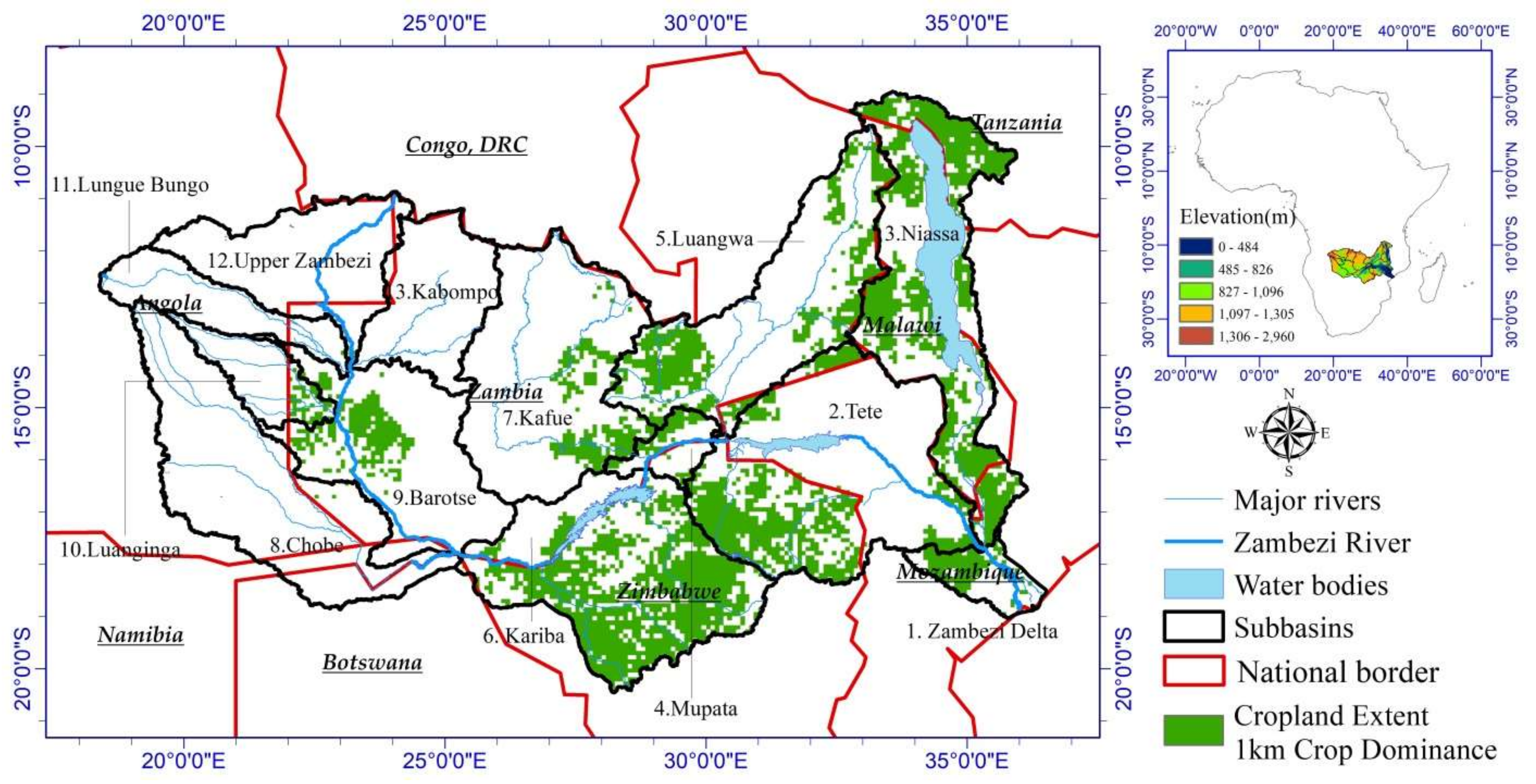
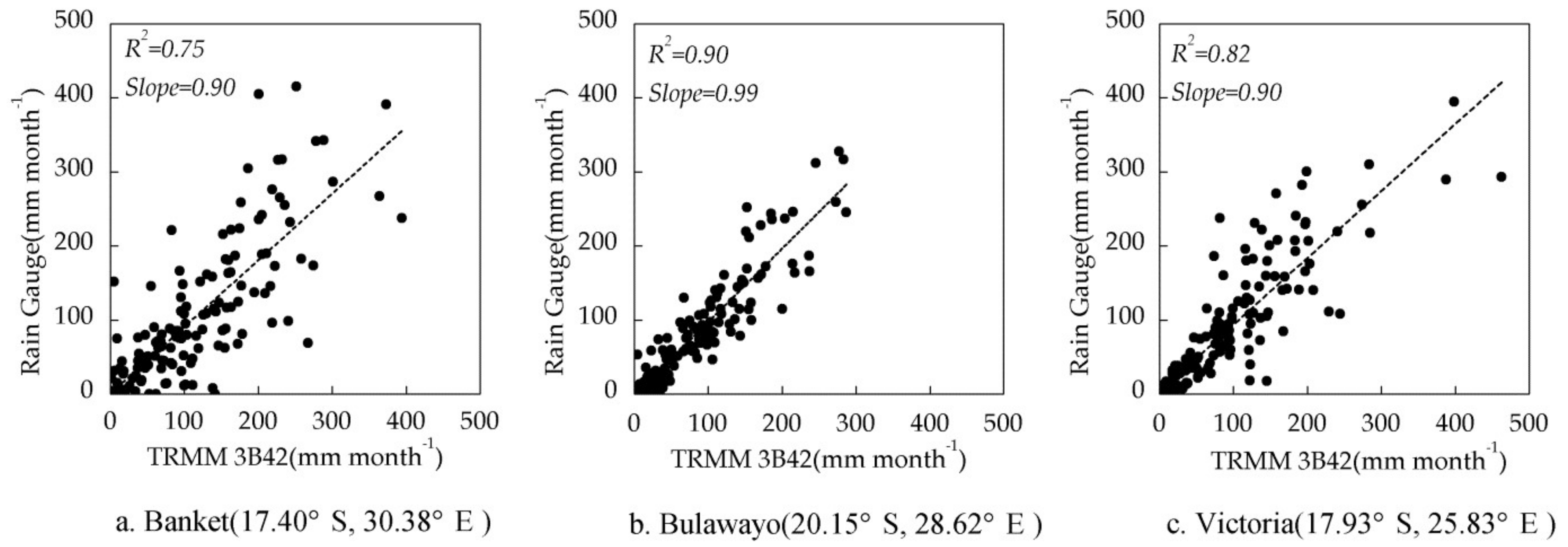


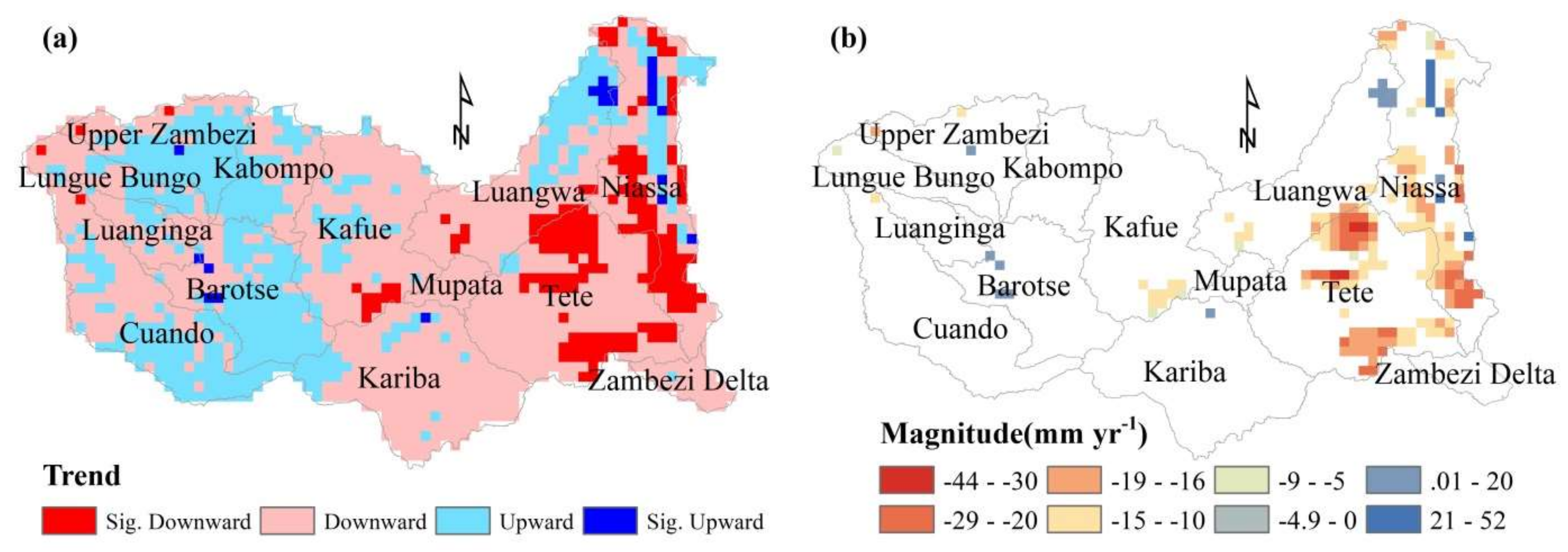
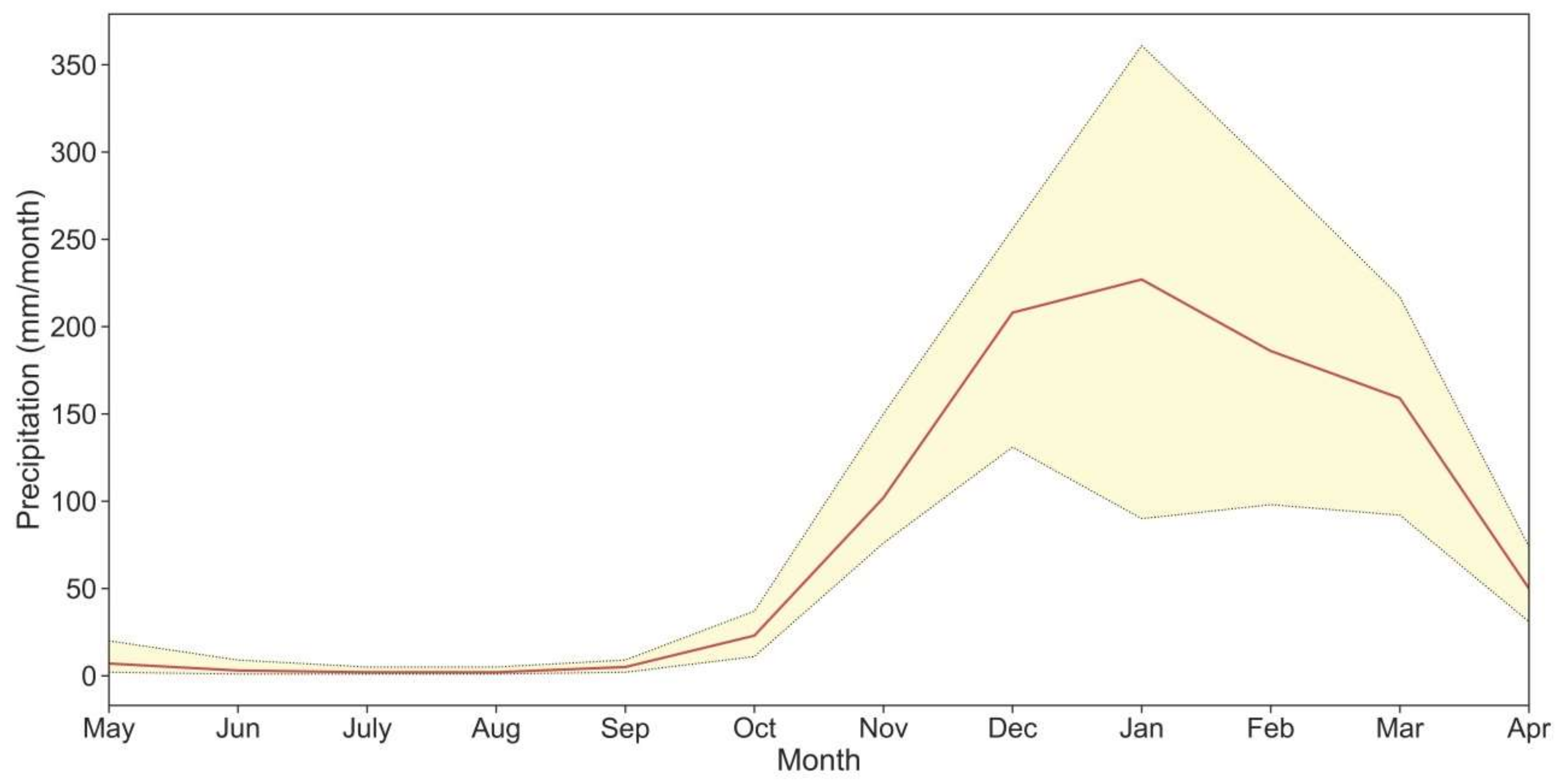
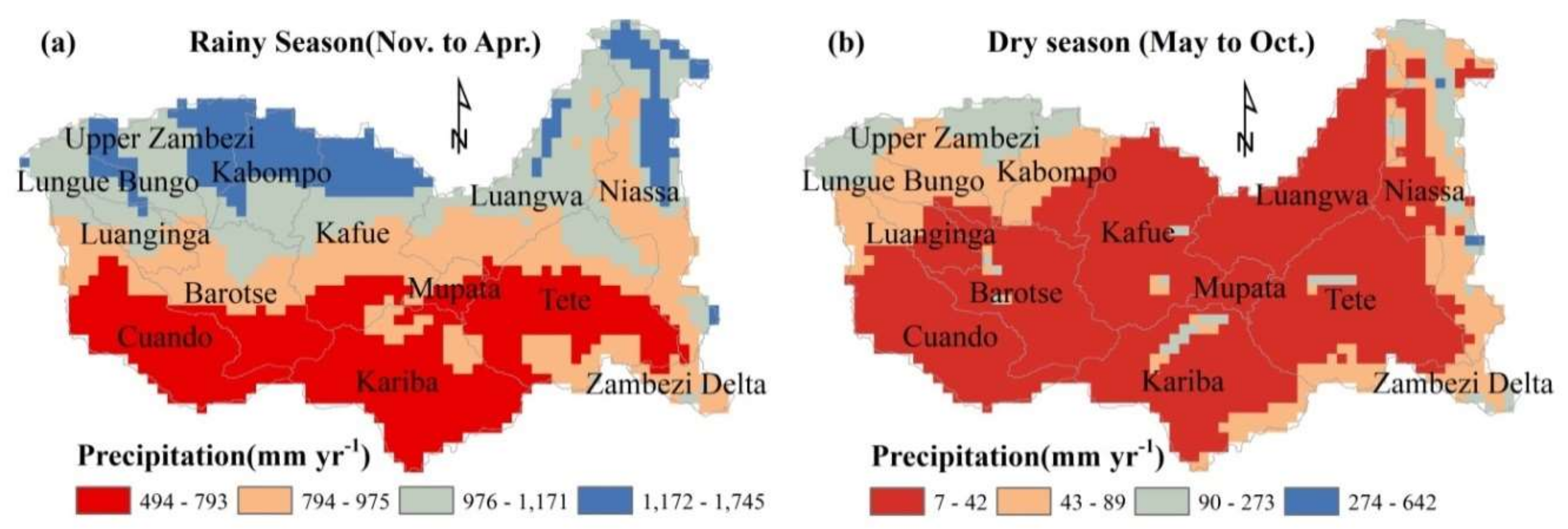
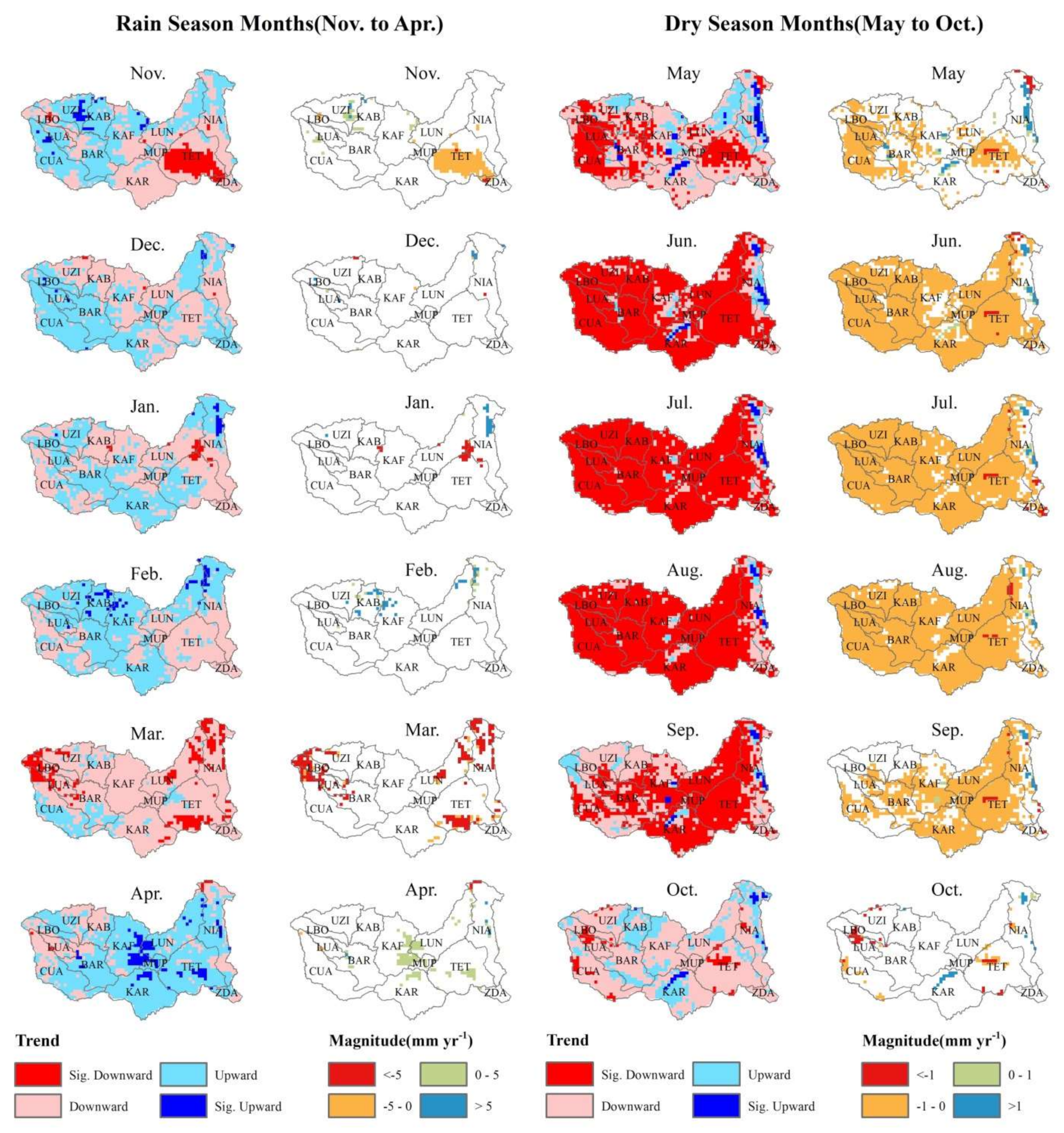
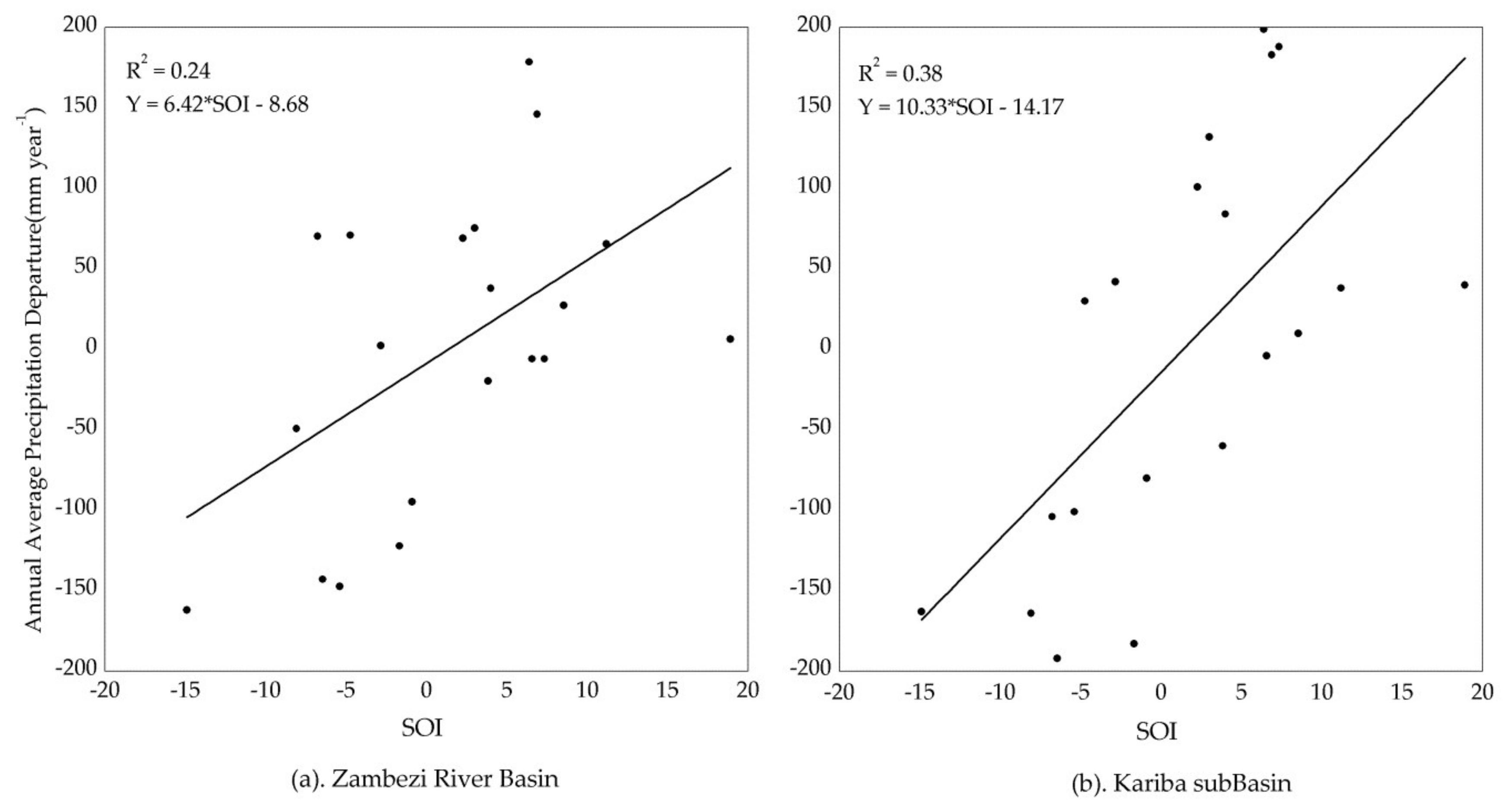
| No. | Sub-Basin Name | Downward | Significant Downward | Upward | Significant Upward |
|---|---|---|---|---|---|
| 1 | Zambezi Delta | 97% | 0% | 3% | 0% |
| 2 | Tete | 99% | 30% | 1% | 0% |
| 3 | Niassa | 77% | 34% | 23% | 5% |
| 4 | Mupata | 100% | 0% | 0% | 0% |
| 5 | Luangwa | 70% | 7% | 30% | 2% |
| 6 | Kariba | 86% | 0% | 14% | 0% |
| 7 | Kafue | 80% | 5% | 20% | 0% |
| 8 | Cuando | 51% | 0% | 49% | 0% |
| 9 | Barotse | 35% | 0% | 65% | 2% |
| 10 | Lungue Bungo | 62% | 2% | 38% | 0% |
| 11 | Luanginga | 70% | 0% | 30% | 1% |
| 12 | Upper Zambezi | 33% | 2% | 67% | 1% |
| 13 | Kabompo | 48% | 0% | 52% | 0% |
| 14 | Zambezi River Basin | 70% | 10% | 30% | 1% |
© 2019 by the authors. Licensee MDPI, Basel, Switzerland. This article is an open access article distributed under the terms and conditions of the Creative Commons Attribution (CC BY) license (http://creativecommons.org/licenses/by/4.0/).
Share and Cite
Zeng, H.; Wu, B.; Zhang, N.; Tian, F.; Phiri, E.; Musakwa, W.; Zhang, M.; Zhu, L.; Mashonjowa, E. Spatiotemporal Analysis of Precipitation in the Sparsely Gauged Zambezi River Basin Using Remote Sensing and Google Earth Engine. Remote Sens. 2019, 11, 2977. https://doi.org/10.3390/rs11242977
Zeng H, Wu B, Zhang N, Tian F, Phiri E, Musakwa W, Zhang M, Zhu L, Mashonjowa E. Spatiotemporal Analysis of Precipitation in the Sparsely Gauged Zambezi River Basin Using Remote Sensing and Google Earth Engine. Remote Sensing. 2019; 11(24):2977. https://doi.org/10.3390/rs11242977
Chicago/Turabian StyleZeng, Hongwei, Bingfang Wu, Ning Zhang, Fuyou Tian, Elijah Phiri, Walter Musakwa, Miao Zhang, Liang Zhu, and Emmanuel Mashonjowa. 2019. "Spatiotemporal Analysis of Precipitation in the Sparsely Gauged Zambezi River Basin Using Remote Sensing and Google Earth Engine" Remote Sensing 11, no. 24: 2977. https://doi.org/10.3390/rs11242977
APA StyleZeng, H., Wu, B., Zhang, N., Tian, F., Phiri, E., Musakwa, W., Zhang, M., Zhu, L., & Mashonjowa, E. (2019). Spatiotemporal Analysis of Precipitation in the Sparsely Gauged Zambezi River Basin Using Remote Sensing and Google Earth Engine. Remote Sensing, 11(24), 2977. https://doi.org/10.3390/rs11242977









